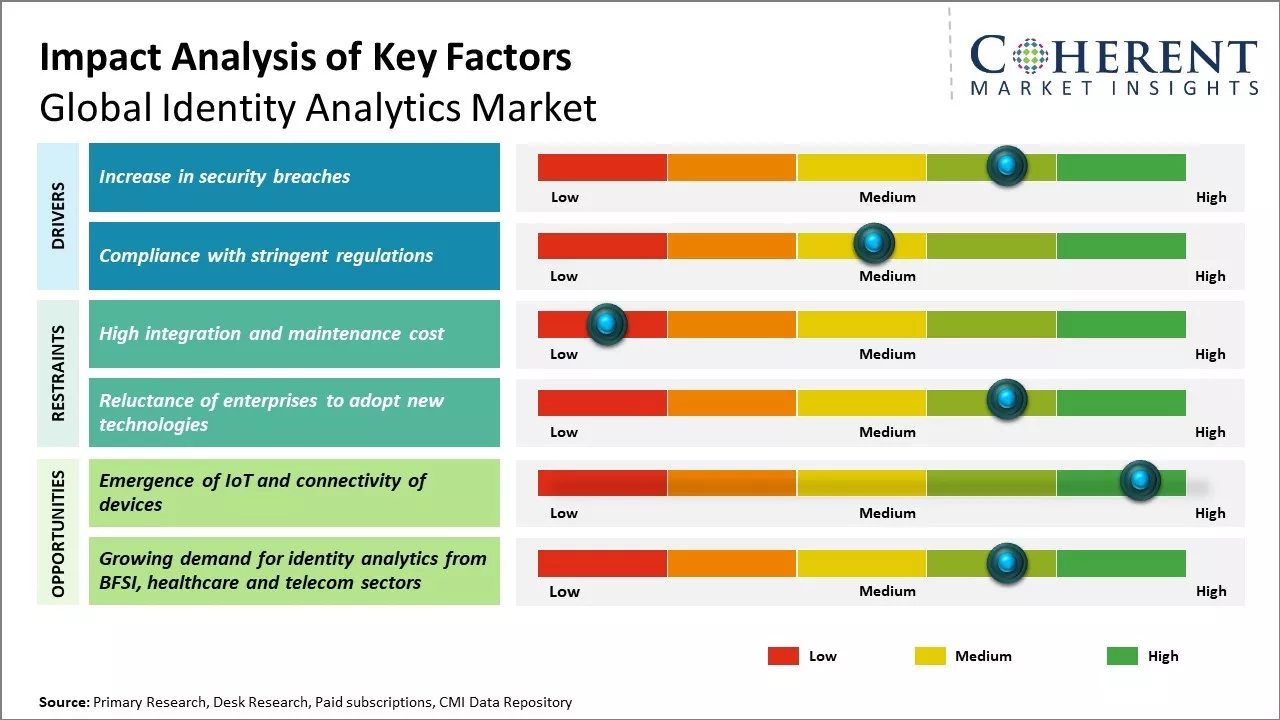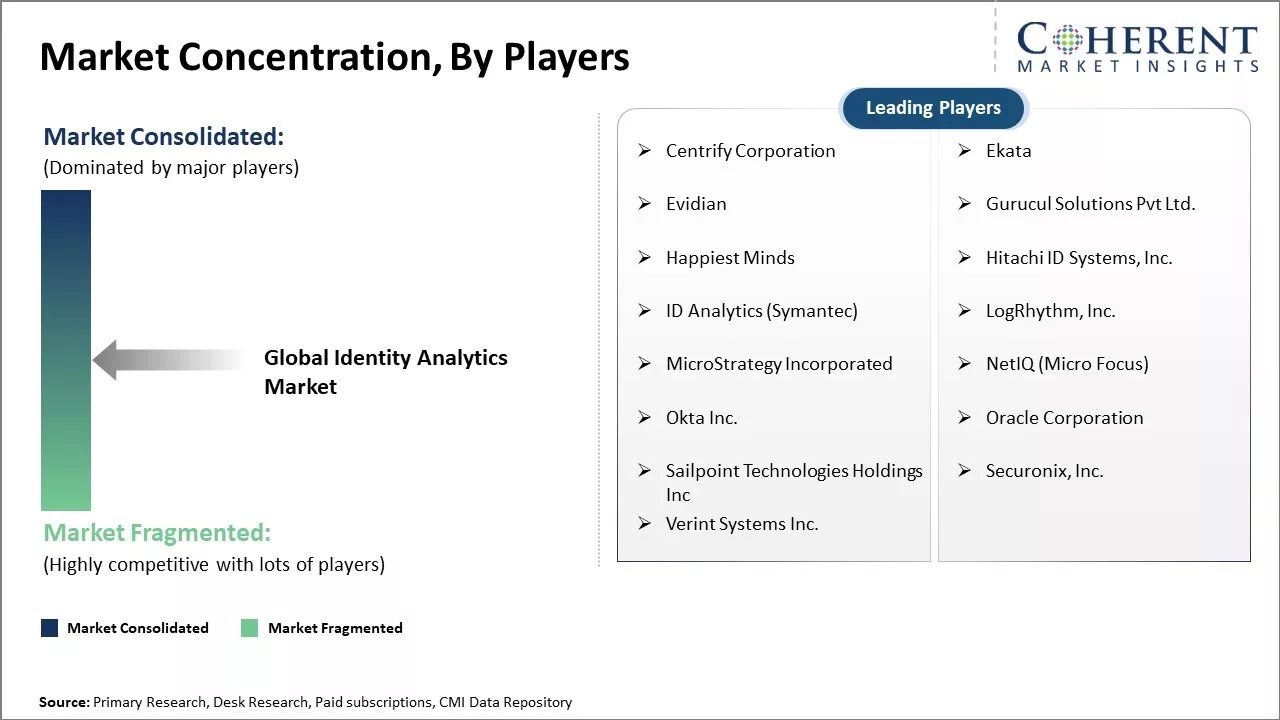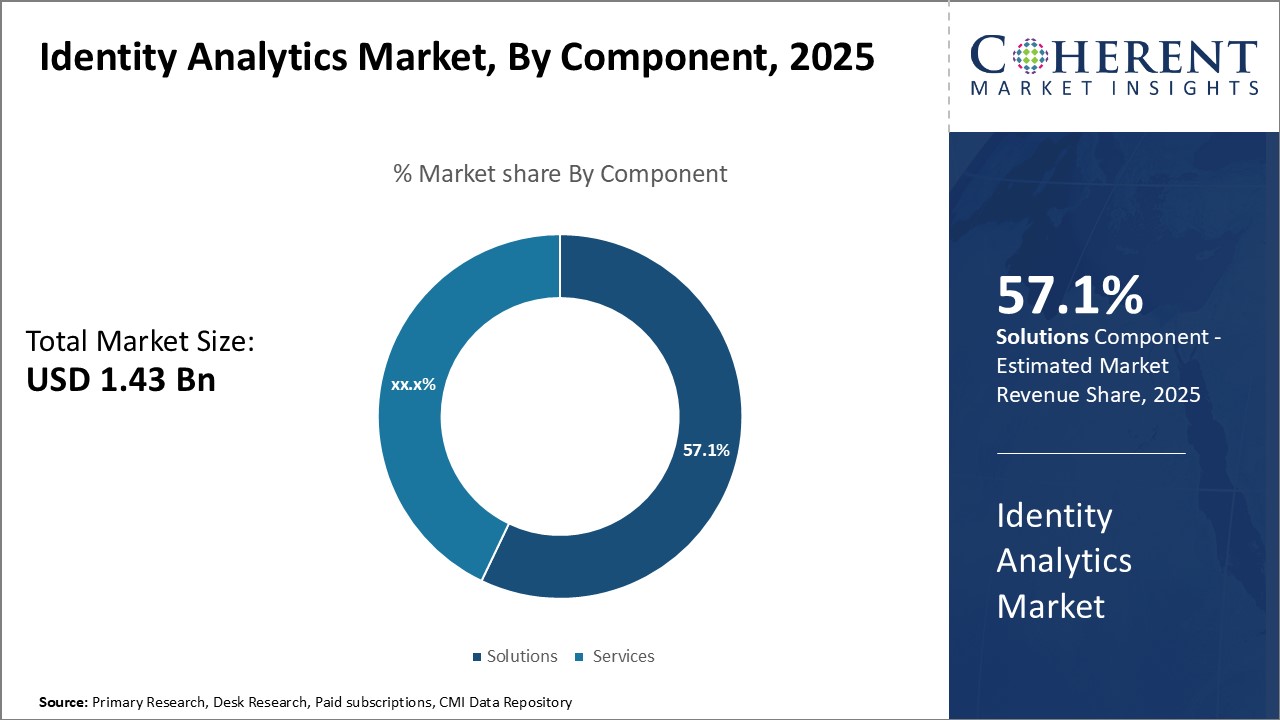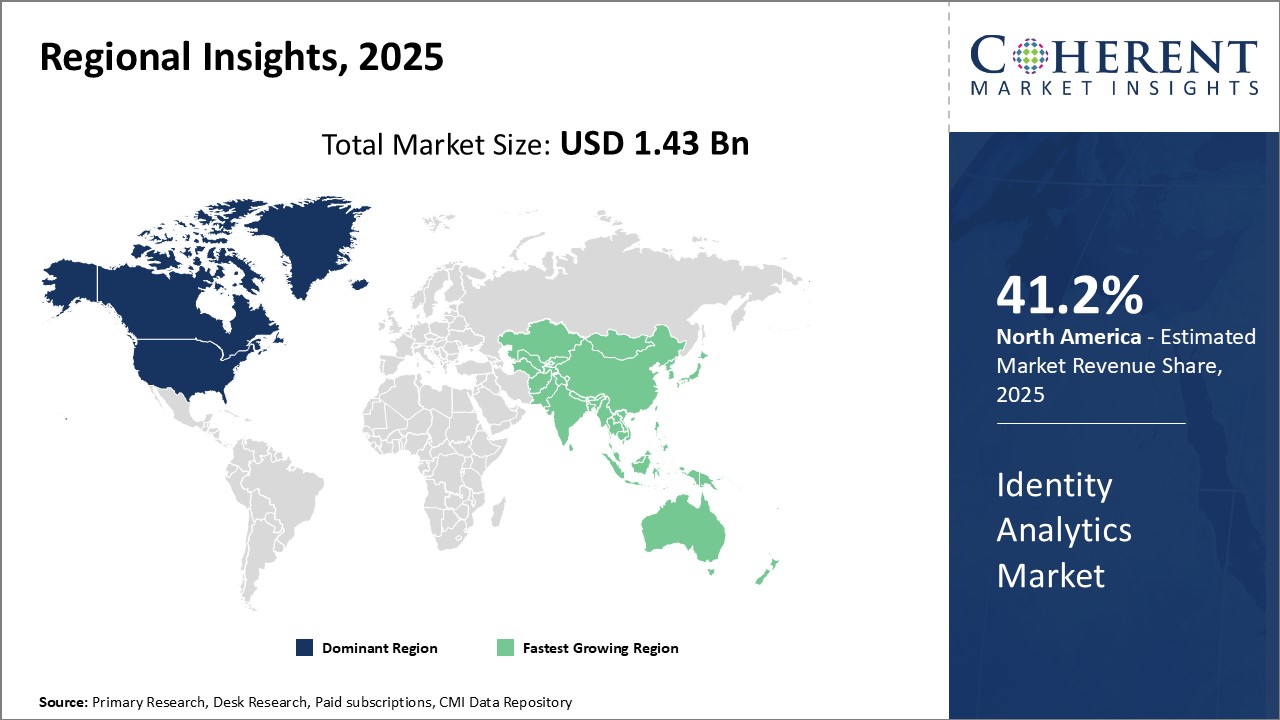Identity Analytics Market Size and Trends
The global identity analytics market is estimated to be valued at US$ 1.43 Bn in 2025 and is expected to reach US$ 7.46 Bn by 2032, exhibiting a compound annual growth rate (CAGR) of 26.6% from 2025 to 2032.

Discover market dynamics shaping the industry: Download Free Sample
The identity analytics market is witnessing high growth on account of rising instances of identity theft, cybercrimes, and increasing regulatory compliances around the world. Stringent data privacy regulations like GDPR (General Data Protection Regulation) and CCPA (California Consumer Privacy Act) have pushed the organizations to focus on identity verification and monitoring of user activities. Furthermore, rapid digitalization and rising adoption of cloud applications have also created the need for robust identity management systems within the enterprises. Growing demand for advanced authentication and authorization systems is another key factor driving more organizations to invest in identity analytics solutions. With technological advancements in AI, ML and analytics, the identity analytics market is expected to grow at a significant pace during the forecast period.
Increase in security breaches
In today's highly digital and connected world, businesses are collecting and storing massive amounts of sensitive data about their customers, employees, and operations. At the same time, the sophisticated techniques employed by cybercriminals to steal valuable information have also become increasingly advanced. It is estimated that a new business falls victim to a data breach every 40 seconds. The typical costs associated with a breach include downtime, lost customers, investigations, notification costs, and regulatory fines - often amounting to millions of dollars for a major company. As such, organizations across all industries are recognizing the importance of implementing robust identity analytics solutions to protect themselves from these costly security risks. By closely monitoring user behavior and access patterns, anomalies can be quickly identified that could indicate malicious activity such as insider threats, hacked credentials, or targeted phishing attacks. Any suspicious events can then be investigated before sensitive data is stolen. The implementation of identity analytics technologies allows businesses to take a more proactive stance towards cybersecurity rather than merely responding to incidents after the fact.
Market Concentration and Competitive Landscape

Get actionable strategies to beat competition: Download Free Sample
Compliance with stringent regulations
Governments around the world have introduced increasingly strict data privacy laws to safeguard individuals from misuse of their personal information. Landmark regulations such as the European Union's General Data Protection Regulation (GDPR) and California Consumer Privacy Act (CCPA) in the U.S. subject companies to substantial penalties if they fail to protect customers' identities and adhere to strict compliance rules. This includes requirements to support rights like access, erasure, and data portability. Maintaining compliance has become an enormous challenge for organizations managing petabytes of user data across hybrid IT environments. Identity analytics platforms provide transparency into who has access to what information and the ability to produce audits on demand validating adherence to privacy mandates. Any access and authorization changes can also be automatically logged. With their capabilities for continuous monitoring, anomaly detection and reporting, these solutions enable firms to remain compliant with privacy laws that aim to give citizens more control over their digital identities and activities online. The risk of non-compliance fines makes identity analytics an essential investment for businesses operating globally.
Key Takeaways from Analyst:
Driven by an increasing necessity among organizations to secure access and detect fraud, the demand for identity analytics solutions is accelerating. Particularly for large enterprises with global operations and millions of customer records, identity analytics has become a top priority to mitigate security and privacy risks.
North America currently dominates the market due to stringent data protection laws and rising digital identity thefts. However, Asia Pacific is expected to be the fastest growing region backed by growing digitization, adoption of advanced technologies, and awareness about identity analytics offerings across countries like China and India. While identity analytics provides opportunities to optimize processes and boost security, data collection and management challenges can hinder complete utilization of these solutions.
As the proliferation of online identities and hybrid work models increases vulnerability points, identity analytics vendors will focus on offering scalable cloud-based platforms for continuous monitoring, detection of anomalies, and risk assessment. Partnerships with other cybersecurity solution providers also present an opportunity to build comprehensive identity governance programs. Although on-premises deployments still have custom requirements, the demand for cloud-based identity analytics is projected to grow substantially in the coming years.
Market Challenges: High integration and maintenance cost
The integration of identity analytics solutions within existing security infrastructure and systems is a complex process that requires significant time, money and effort from organizations. These solutions need to be seamlessly integrated with directories, directories, applications, databases and other identity platforms that may have been in use for several years. Any mismatches or errors during integration can compromise security and privacy. Ensuring proper system integration across different internal departments and technologies is a huge challenge for many firms. The costs of hiring skilled integration experts and opportunity costs of deployment during integration can be very high. This level of investment deters many small and medium enterprises from adopting identity analytics solutions.
Additionally, maintaining identity analytics solutions and keeping them updated with the latest technologies also places a considerable cost burden on organizations. Authentication and authorization mechanisms keep evolving with new threats emerging every day. Solution providers need to regularly release updates to patch vulnerabilities, add new features and optimize performance. Analyzing tremendous volumes of identity data on an ongoing basis also requires high computing power and data storage capacities. All of these ongoing maintenance activities involve recurring license fees, support contracts, infrastructure investments and manpower costs.
Market Opportunities: Emergence of IoT and connectivity of devices
The emergence of the Internet of Things (IoT) and increased connectivity of devices is poised to be a great opportunity for the global identity analytics market. As more "things" and devices become connected to the internet, from home appliances to industrial machinery to transportation and more, each one will need a unique digital identity to function securely and interact with other systems. This massive growth in the number of connected "identities" will drive tremendous demand for identity analytics technologies and solutions.
Furthermore, the complex requirements of handling IoT identity analytics - including the episodic and incomplete nature of sensor data, distributed and edge-based processing models as well as strict regulations around privacy and security in some verticals - demand highly sophisticated and specialized capabilities from vendors. This specialized nature of IoT use cases represents a substantial greenfield opportunity for focused identity analytics providers to establish beachheads and tailor their platforms for the IoT era. Given the projected explosive growth of IoT networks and the value that can be unlocked through identity-driven insights, it is likely to significantly expand the contours of the global identity analytics market in the coming years.

Discover high revenue pocket segments and roadmap to it: Download Free Sample
Insights By Component - Leveraging Advanced Capabilities, Solutions Drive Identity Analytics Adoption
Within the global identity analytics market in terms of component, the solutions segment is expected to contribute 57.1% share in 2025 owing to its advanced capabilities to address evolving identity and access management needs. Identity analytics solutions offer comprehensive visibility across identities, applications, systems, and infrastructure to identify threats, anomalies, and risks. They leverage machine learning and behavioral analytics to gain valuable insights from huge volumes of identity and log data. This helps organizations strengthen security posture, ensure compliance, and optimize existing access privileges.
Key identity analytics solutions include identity governance, access management, fraud detection and risk-based authentication. Identity governance solutions deliver workflow-based administration and provisioning of identities throughout their lifecycle. They enable centralized management of identities, entitlements, access certifications and segregation of duties. Access management solutions deliver just-in-time provisioning of access based on need, enhancing productivity while maintaining security. Fraud detection solutions leverage behavioral biometrics and anomaly detection algorithms to identify fraudulent activities in real-time. Risk-based authentication solutions deliver step-up authentication for high-risk transactions and geolocations through advanced algorithms.
The advanced capabilities of solutions to identify threats proactively, simplify access management and ensure regulatory compliance have accelerated their adoption across industries. Rapid digital transformation and remote working trends have further increased the need to strengthen identity governance practices and optimize the identity lifecycle. Large-scale deployment of cloud, IoT and mobile applications have also expanded the attack surface, driving the need for comprehensive identity analytics platforms. Favorable government mandates around data privacy and security are also propelling investments in robust identity governance solutions. Going forward, integration of AI/ML and Blockchain to enhance threat detection and access certification will further augment the solutions segment.
Insights By Deployment - Leveraging Scalability and Cost Benefits, Cloud Adoption Continues Unabated
Within the deployment segment, the cloud-based segment is expected to contribute 58.6% of the market share in 2025 owing to its scalable architecture and optimized total cost of ownership. Cloud identity analytics platforms remove the need for upfront infrastructure investments and recurring maintenance costs. They offer instant scalability and flexibility to elastically scale resources based on business demand. Cloud providers take responsibility of regular software upgrades, patching and infrastructure maintenance through a simple pay-as-you-go pricing model. This helps greatly reduce capital and operational expenditures for organizations.
Key cloud platforms offered include Software-as-a-Service (SaaS) and Platform-as-a-Service (PaaS) models. SaaS solutions offer pre-configured, turnkey implementations with subscription-based licensing. They simplify deployment with no upfront license costs. PaaS platforms provide deployment flexibility and control over customizations and integrations onto cloud infrastructure with metered usage billing. Both models deliver seamless scalability, global availability, enhanced collaboration and mobile access capabilities.
Rapid migration to remote work environments amid pandemic accelerated cloud adoption. Advanced security features of cloud platforms including user behavior analytics, access reviews and threat detection have also boosted their attractiveness. Furthermore, cloud solutions integrate innovation more rapidly with frequent feature upgrades. This helps future-proof identity investments. Driven by scalability, agility and long-term cost advantages, cloud continues to dominate new deployments and replacement of legacy on-premises systems. Hybrid and multi-cloud operations are also emerging to diversify infrastructure risks.
Insights By End-use Industry - Enhanced Security and Compliance Needs Fuel BFSI Adoption
Among end-use industry, BFSI segment is expected to contribute 34.3% share in 2025 to identity analytics adoption owing to stringent regulatory mandates and distributed threat landscape. With growing customer expectations of privacy and digital services, BFSI organizations face increased pressure to securely deliver experiences across multi-cloud applications. They need comprehensive visibility and governance across identities, entitlements and access patterns to proactively detect fraudsters, comply with regulations and identify insider threats.
Key drivers include enhanced due diligence needs under Know Your Customer (KYC) norms, protection of customer personally identifiable information (PII) as mandated by privacy laws like GDPR, and restrictions on unauthorized access of critical financial systems. Identity analytics helps BFSI organizations simplify KYC workflows, automate access reviews and certifications needed for SOX compliance. Advanced machine learning algorithms aid early detection of money laundering activities and suspicious login behaviors. Risk-based authentication strengthens multi-factor protection for high-value transactions.
Rapid surge in digital banking and contactless payments during pandemic has further increased the need for robust identity governance practices in BFSI. Comprehensive identity analytics platforms effectively address the complex regulatory, security and customer experience needs of BFSI vertical. They play a crucial role in building long-term trust with customers and regulators alike. This will continue propelling the BFSI segment as a dominant user of identity analytics solutions.
Regional Insights

Need a Different Region or Segment? Download Free Sample
North America has traditionally dominated the global identity analytics market. The region is expected to account for 41.2% of the market share in 2025, given the strong presence of leading vendors and early adopter customers across various industry verticals in this region. The U.S., in particular, has witnessed major deployments of identity analytics solutions by organizations across the banking, financial services, healthcare and government sectors over the last decade to strengthen access control and privilege management across on-premise as well as cloud-based applications and systems.
The availability of technical skills and high digital awareness among enterprise security teams has complemented vendors focused on developing advanced identity analytics capabilities around user behavior analysis, entity relationship monitoring and anomaly detection. Leading players have also established their largest research and development centers in countries like the U.S. and Canada to continue innovating solutions tailored for the evolving compliance needs of customers. Additionally, North America remains an attractive testing ground for pilot projects and large-scale proof-of-concept deployments, before international expansion.
The Asia Pacific region has emerged as the fastest growing regional market for identity analytics globally in recent years. Countries like China, India, Japan and South Korea have witnessed exponential growth in digital identities stemming from enterprises rapid adoption of cloud, mobile and IoT technologies. This has propelled the need for robust user monitoring and access control frameworks. At the same time, governments in Asia Pacific have also stepped-up regulations around data privacy, cybersecurity and borderless authentication, driving broader adoption of identity analytics platforms.
Homegrown vendors as well as international players have set up local offices, data centers and support centers across major Asia Pacific markets to tap into the opportunities presented. Organizations of varied sizes across industry verticals have recognized the importance of credential monitoring and privileged access control to secure identities in today's complex threat landscape. This makes Asia Pacific a lucrative and emerging frontier for continued investments and innovations in the identity analytics domain.
Market Report Scope
Identity Analytics Market Report Coverage
| Report Coverage | Details | ||
|---|---|---|---|
| Base Year: | 2024 | Market Size in 2025: | USD 1.43 Bn |
| Historical Data for: | 2020 To 2024 | Forecast Period: | 2025 To 2032 |
| Forecast Period 2025 to 2032 CAGR: | 26.6% | 2032 Value Projection: | USD 7.46 Bn |
| Geographies covered: |
|
||
| Segments covered: |
|
||
| Companies covered: |
Centrify Corporation, Ekata, Evidian, Gurucul Solutions Pvt Ltd., Happiest Minds, Hitachi ID Systems, Inc., ID Analytics (Symantec), LogRhythm, Inc., MicroStrategy Incorporated, NetIQ (Micro Focus), Okta Inc., Oracle Corporation, Sailpoint Technologies Holdings Inc, Securonix, Inc., and Verint Systems Inc. |
||
| Growth Drivers: |
|
||
| Restraints & Challenges: |
|
||
Uncover macros and micros vetted on 75+ parameters: Get instant access to report
Identity Analytics Industry News
- In August 2022, Gurucul, a provider of next-generation security information and event management (SIEM), extended detection and response (XDR), user and entity behavior analytics (UEBA), and identity and access analytics, announced expanded support for poly-cloud architecture. This includes improved multi-cloud deployments and cross-cloud capabilities across major cloud platforms, such as Amazon Web Services. These new cross-cloud features enable correlation, advanced linking, and behavior baselines on access and activity across different cloud environments.
- In February 2022, LogRhythm unveiled its new brand identity, which represents the company's efforts to assist security operations teams in addressing staffing shortages, enhancing their knowledge of emerging attacks and technologies, and navigating the ever-evolving threat landscape with confidence. This rebranding is the first of many changes planned for LogRhythm in 2022, including a fresh visual design, the development of a cloud-native platform, and new perspectives that reflect the company's vision and evolution.
- In January 2022, RBL Bank, India, announced a strategic partnership with Google to enhance its customer experience strategy and expand its value proposition through the Abacus 2.0 digital platform. This collaboration aims to efficiently manage customer data and analytics, facilitate effective cross-selling, and significantly reduce customer acquisition costs, thereby optimizing the overall customer experience.
- In June 2021, Stripe launched Stripe Identity, a tool that enables online businesses to easily and securely verify the identities of users from over 30 countries. Stripe Identity is the first self-service solution of its kind, allowing any business to start verifying user identities within minutes, without the need for any coding. This makes identity verification as straightforward for businesses as accepting payments through Stripe.
*Definition: The global identity analytics market provides identity and access management solutions that help organizations analyze user behavior and activities to detect anomalies, reduce risks from compromised credentials, ensure compliance policies are being followed, and gain insights into how users are accessing critical systems and data. Identity analytics solutions collect and analyze log and event data to generate identity risk scores and recommendations to strengthen security protections across an organization's network and applications.
Market Segmentation
- Component Insights (Revenue, US$ Bn, 2020 - 2032)
- Solutions
- Services
- Deployment Insights (Revenue, US$ Bn, 2020 - 2032)
- Cloud-based
- On-premises
- End-use Industry Insights (Revenue, US$ Bn, 2020 - 2032)
- IT and Telecommunication
- BFSI
- Government
- Retail and Consumer
- Healthcare
- Manufacturing
- Energy and Power
- Others
- Regional Insights (Revenue, US$ Bn, 2020 - 2032)
- North America
- U.S.
- Canada
- Latin America
- Brazil
- Argentina
- Mexico
- Rest of Latin America
- Europe
- Germany
- U.K.
- Spain
- France
- Italy
- Russia
- Rest of Europe
- Asia Pacific
- China
- India
- Japan
- Australia
- South Korea
- ASEAN
- Rest of Asia Pacific
- Middle East & Africa
- GCC Countries
- Israel
- South Africa
- Rest of Middle East & Africa
- North America
- Key Players Insights
- Centrify Corporation
- Ekata
- Evidian
- Gurucul Solutions Pvt Ltd.
- Happiest Minds
- Hitachi ID Systems, Inc.
- ID Analytics (Symantec)
- LogRhythm, Inc.
- MicroStrategy Incorporated
- NetIQ (Micro Focus)
- Okta Inc.
- Oracle Corporation
- Sailpoint Technologies Holdings Inc
- Securonix, Inc.
- Verint Systems Inc.
Share
Share
About Author
Suraj Bhanudas Jagtap is a seasoned Senior Management Consultant with over 7 years of experience. He has served Fortune 500 companies and startups, helping clients with cross broader expansion and market entry access strategies. He has played significant role in offering strategic viewpoints and actionable insights for various client’s projects including demand analysis, and competitive analysis, identifying right channel partner among others.
Missing comfort of reading report in your local language? Find your preferred language :
Transform your Strategy with Exclusive Trending Reports :
Frequently Asked Questions
EXISTING CLIENTELE
Joining thousands of companies around the world committed to making the Excellent Business Solutions.
View All Our Clients
